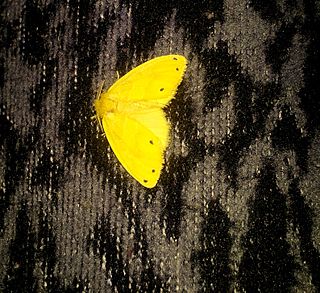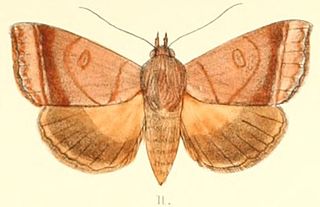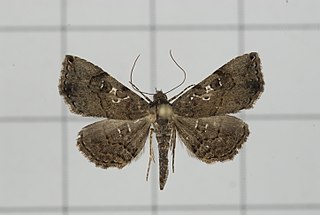Related Research Articles

Yepcalphis is a monotypic moth genus of the family Noctuidae erected by Nye in 1975. Its only species, Yepcalphis dilectissima, was first described by Francis Walker in 1858. It is found in Sri Lanka, the Oriental tropics, the Philippines, Sulawesi and the Sula Islands.

Artaxa is a genus of tussock moths in the family Erebidae erected by Francis Walker in 1855. Some of the species have urticating hairs.

Aporandria is a monotypic moth genus in the family Geometridae described by Warren in 1894. Its single species, Aporandria specularia, was first described by Achille Guenée in 1857. It is found in Sri Lanka, India, Vietnam, Thailand, the Andamans, Peninsular Malaysia, Sumatra, Borneo, the Philippines and Sulawesi.

Achaea serva is a species of noctuid moth of the family Erebidae first described by Johan Christian Fabricius in 1775. It is found from the Indo-Australian tropics of India, Sri Lanka, Myanmar, China, Borneo, Hong Kong, Java, the Philippines, the New Hebrides, to Okinawa, many western Micronesian islands and New Guinea and Australia.

Ophiusa trapezium is a moth of the family Erebidae first described by Achille Guenée in 1852. It is found from the Indo-Australian tropics of India, Sri Lanka to Queensland, the Bismarck Islands and New Caledonia. Adults are fruit piercers.

Oraesia emarginata is a species of moth of the family Erebidae first described by Johan Christian Fabricius in 1794. It is found in Australia, New Caledonia, Indonesia, New Guinea, Pakistan, the Philippines, India, Sri Lanka, Sulawesi, Taiwan, China, Japan, Korea and Nepal as well as Eritrea, Ethiopia, Kenya, Namibia, Nigeria, South Africa, Tanzania, the Gambia, Uganda, Oman and Yemen.

Calluga costalis is a moth of the family Geometridae. The species was first described by Frederic Moore in 1887. It is found in Sri Lanka, Taiwan, Borneo, Bali, Sulawesi, Seram, New Guinea and Queensland.

Teulisna tumida is a species of moth of the family Erebidae first described by Francis Walker in 1862. It is found in Borneo, Sumatra, China, India, Sri Lanka, Thailand and Taiwan.

Thumatha fuscescens is a moth of the family Erebidae first described by Francis Walker in 1866. It is found in Australia, South-East Asia, India, Sri Lanka, the Comoros, Réunion, Madagascar and Gabon.
Herochroma clariscripta is a moth of the family Geometridae first described by Jeremy Daniel Holloway in 1996. It is found on Borneo.
Bosara emarginaria is a moth in the family Geometridae first described by George Hampson in 1893. It is found on Borneo and in Sri Lanka, the north-eastern Himalayas and Hong Kong. The habitat consists of lowland dipterocarp forests.
Ziridava xylinaria, the indistinct carpet, is a moth in the family Geometridae. The species was first described by Francis Walker in 1863. It is found in Sri Lanka, India, Hong Kong and on Peninsular Malaysia, Borneo, Java and possibly the Philippines and Sulawesi.
Narosodes punctana is a moth of the family Erebidae. It was described by Francis Walker in 1863. It is found in Sri Lanka and India and on Borneo.
Manoba shrimptoni is a moth in the family Nolidae. It was described by Jeremy Daniel Holloway in 2003. It is found on Borneo. The habitat consists of montane areas.
Oxacme commotoides is a moth in the subfamily Arctiinae. It was described by Jeremy Daniel Holloway in 2001. It is found on Borneo. The habitat consists of lower montane forests and dipterocarp forests.
Thumatha orientalis is a moth in the family Erebidae first described by Jeremy Daniel Holloway in 2001. It is found in Sri Lanka and on Borneo. The habitat consists of lowland areas.
Eupterote harmani is a moth in the family Eupterotidae. It was described by Jeremy Daniel Holloway in 1987. It is found on Borneo. The habitat consists of hill dipterocarp and upper montane forests.

Rhesala imparata is a moth of the family Erebidae first described by Francis Walker in 1865. It is sometimes referred to as an Albizia defoliator. It is found in Sri Lanka, India, Taiwan, Singapore and Borneo.

Amblychia hymenaria is a moth of the family Geometridae first described by Achille Guenée in 1858. It is found in India, Singapore, Sundaland, Sulawesi, Nepal, Bangladesh, Malaysia and may be in Sri Lanka.
Dysaethria scopocera is a moth of the family Uraniidae first described by George Hampson in 1896. It is found in Sri Lanka, Taiwan, Malaysia and Borneo.
References
- ↑ "Species Details: Monobolodes parvinigrata Holloway, 1998". Catalogue of Life. Retrieved 28 March 2018.
- ↑ Koçak, Ahmet Ömer; Kemal, Muhabbet (20 February 2012). "Preliminary list of the Lepidoptera of Sri Lanka". Cesa News. Centre for Entomological Studies Ankara (79): 1–57 – via Academia.
- ↑ Holloway, Jeremy Daniel. "Monobolodes parvinigrata sp. n." The Moths of Borneo. Retrieved 28 March 2018.
| This Uraniidae-related article is a stub. You can help Wikipedia by expanding it. |